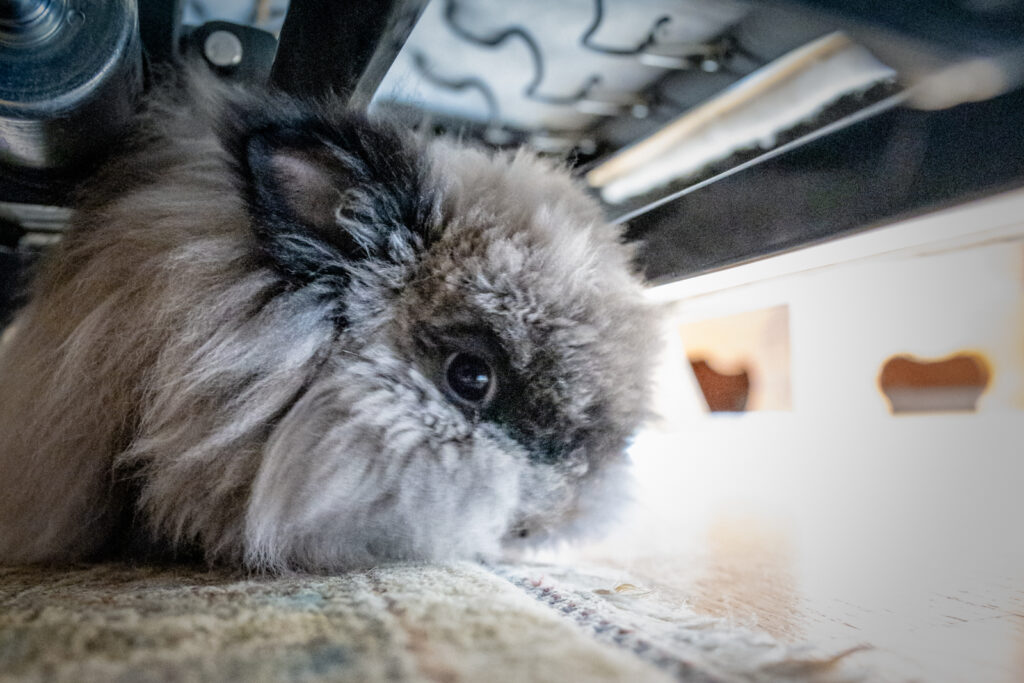One of the most common misconceptions people have about rabbits is that they like to be held and cuddled. This is probably because they look like plush toys. Unfortunately, many people buy rabbits without realizing the true nature of rabbits, and that’s one of the main reason these lovely, intelligent creatures are “dumped” shortly after they reach sexual maturity and begin to assert their strong personalities.
My bunny doesn’t like to be held. What can I do?
You are distressed that the bunny does not like to be held. Consider for a moment, however, the natural history of the rabbit. This is a ground-dwelling animal that is a prey item for many predators. It is completely against the nature of the rabbit to be held far above the ground where it cannot control its own motions and activities. When you force her to be held against her will, you reinforce her notion that you are a predator who is trying to restrain her. Holding her while she struggles and kicks is not only dangerous for you and the children (I think you’ve probably noticed her sharp claws by now!), but for the rabbit. I wish I didn’t know how many young rabbits come into our vet’s office with broken legs, necks and spines because people *insisted* on carrying them around and handling them against their will. I know you love your bunny, and won’t let this happen to her.
After all…you probably wouldn’t force a dog who didn’t want to be carried. Why treat your bunny any differently, simply because of her superficial appearance?
How can I better understand my bunny’s shy behavior?
To understand rabbit behavior, you have to begin to think more like a rabbit! 🙂
Step 1. Buy a copy of The House Rabbit Handbook by Marinell Harriman. It’s the only accurate book on the market about rabbit behavior. Throw out your other books! 😉
Step 2. Important to note: A rabbit, unlike a dog or cat, evolved as a *prey* species. Dogs and cats are predators. Also, dogs and cats have been bred for centuries to not be afraid of humans. Rabbits have been bred primarily for meat, fur and physical characteristics. That means that when you adopt a bunny, you adopt a lovely, domestic animal with the heart and spirit of a wild animal. It is much more challenging to win the trust of this sensitive, intelligent creature than it is to win the heart of a puppy or kitten, who has been bred to trust you from birth.
Most rabbits are naturally shy. It is up to you, the flexible human, to compromise and alter your behavior so that the bunny understands that you are a friend.
How can I win back my rabbit’s trust?
Here’s the best way to win your rabbit’s trust:
- You and bunny should be together in a private, quiet room. No other pets. No distractions.
- Have a little treat, such as a carrot or a tiny piece of apple, banana or a little pinch of oats in your hand.
- Lie on your tummy on the floor and let the bunny out. Don’t expect him to approach you right away. Remain quiet and patient, even if it takes an hour or more. Rabbits are naturally curious, and eventually, he will come over to sniff you.
- Resist the temptation to reach out and pet the bunny. Instead, let him sniff you, hop on you and just get to know your smell. This will teach him that you are not a threat. Since your bunny already likes to be petted, this probably won’t be a problem!
- If the bunny finds the treat you have, hold it while he nibbles.
- Do this every day. Gradually, you can start to pet the bunny by giving him a gentle “scritch” on the forehead (bunnies love this!). Never force anything, and *never* chase the bunny. This will only undo all the patient sitting you have done to gain his trust.
- Once the bunny learns that you are a friend, he will bond very strongly to you. It’s important to have him neutered (or her spayed, if it’s a girl) once s/he reaches sexual maturity, because otherwise s/he’ll want to make love to everything. Spay/neuter will stop this behavior, and it will eliminate the very real risk of ovarian/uterine cancer in females. Spay/neuter will also make litterbox training easier and more reliable. Be sure you have a vet do this who is *very experienced* with rabbits! If you tell me your general geographic area, I may be able to refer you to a good bunny vet.
- Imagine what the world looks like to this bunny. She’s surrounded by a new environment, and there’s a big, strange-smelling animal that’s always looming over her. She has no idea you’re trying to be friendly. Her “hard wiring” says: “AAAAAAAA!!! It’s going to EAT MEEEE!!!!” So it’s up to you, the new bunny parent, to provide her with quiet, safe space where he can learn to feel secure.
Also: when bringing your bunny out for a romp, instead of pulling her out of the cage, rig the cage so that you can open the door and she can come and go as she pleases. (If the cage has a ramp, be sure to cover the wire with a towel or mat so her foot doesn’t get caught!)
If you continually drag her out and put her into the cage, she will have a harder time learning to trust. Rabbits like to be the masters of their own mobility! They hate being carried around, even though they look like little stuffed toys. They have very strong personalities, and can be very aggressive when they feel threatened.
Be sure all electrical wires and phone cords are out of the bunny’s reach!
Try to see the world through your bunny’s eyes, and put yourself in her place. No one speaks her language, she has been taken from her family and the only home she has ever known, and she has no idea whether you plan to love her, cage her forever, or eat her! You need to gradually and patiently earn her trust. It can take days, weeks or months, and depends on the personality of the individual rabbit.
Help! The rabbit is not turning out to be the sort of pet we wanted for our kids.
Rather than being disappointed that the rabbit is not what you expected (it is unlikely that she will ever learn to *like* to be held. A few rabbits do, but it’s very unusual.), take this opportunity to teach the kids respect for a new kind of animal. If they really want something to carry around, they need a stuffed toy–not a live rabbit. Or perhaps a very gentle cat. (Cats and rabbits can be *great* companions, once they get to know one another.) I’m sure there are many lovely cats at the local shelter, needing homes. The House Rabbit Handbook has an entire chapter devoted to introducing rabbits to other species successfully.
Finally, I’m hoping that the ultimate responsiblity for the rabbit’s welfare is yours–and not your childrens’. They are far too young to understand the necessity of constant, devoted care to another sentient life form. But this is your opportunity to teach them that, too!
I hope you’ll consider all I’ve said and try to look at your rabbit with new eyes. She is not a toy; she is a highly intelligent, potentially loving, loyal creature who can become a member of the family, if you allow her to be what she is–a rabbit! If you can do that, you are in for the most delightful companionship you can imagine.
Is there a place I can go to get support?
Consider joining EtherBun, a free electronic mailing list about rabbit health, care and behavior. It’s an excellent forum for all your questions about your new bunny pal!

